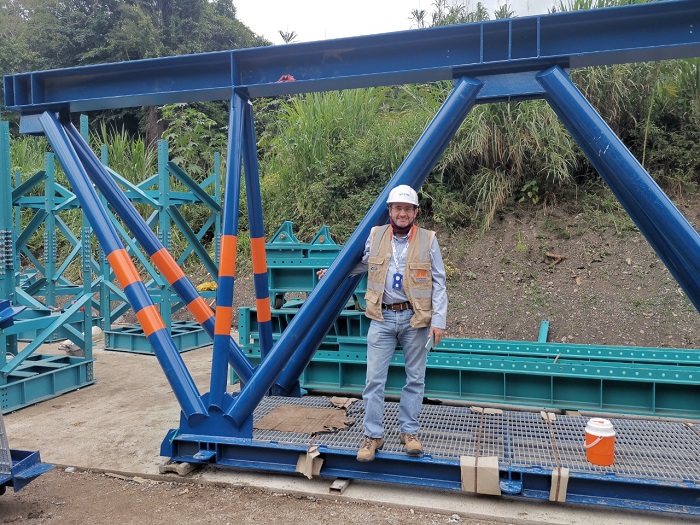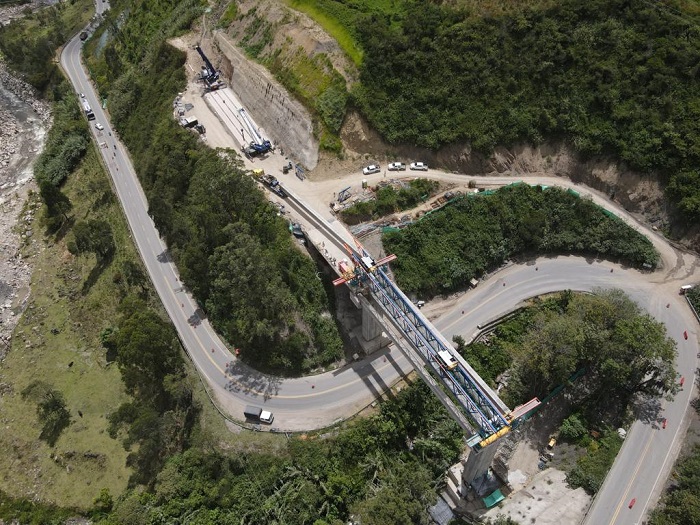As they say, every crisis is an opportunity. This is what happened to our colleagues at Sacyr Engineering and Infrastructures; they were facing a problem in certain bridge construction sites that were particularly difficult to reach due to their meandering shapes.
Rafael Pablo Guillen Carmona, Director of Engineering of Sacyr Construction, has developed the launching gantry RPGC-21 to solve this very same problem at the Pamplona-Cúcuta project in Colombia. This project includes the construction of 22 continuous beam bridges with 1-5 individual spans and is located in a steep valley.
This launching gantry was 100% designed in house, from planning the different elements that give the equipment its movement, to the loader structure or the management of the contractor and production. Its use is intended for areas of difficult access and simply supported bridges or with not many spans.
It has a 90-ton capacity and a maximum 48-m length between spans, which allows to install beams up to 43 meters long.
Bridges with not many spans are very common in roads with large sections, and this launching gantry presents a quick and effective solution, as opposed to conventional launcher devices, which are not as cost-time effective.

Rafael Pablo Guillen Carmona, Director of Engineering of Sacyr Construction, has developed the launching gantry RPGC-21.
“With this design we reduce costs compared to a conventional self-launching device, as it requires less metal to build its structure. As it is not self-launching, its assembly and disassembly is done with auxiliary cranes. This way, assembly times are reduced from two weeks to two days”, explains the inventor, Rafael Pablo Guillén.
“By assembling all the beams, we make up for the entirety of the cost of the equipment, which allows the company to use the launcher gantry for other projects. This considerably reduces the cost of beams, as its assembly is already taken care of”, explains Carlos Rojas, Structures manager of this project. Additionally, all the staff members involved in this project are from the local community.
Load and transportation of the bridge components from one site to another is easier, as the different elements are light and modular, and it does not require any special maneuvers to adapt to the road’s radius or slope.
In only requires two or three trips to transport the entire structure. A conventional launching gantry has many components, and its transportation requires multiple trips, which, if there is quite a bit of distance to cover, can have a significant impact on cost an time.

Another advantage is that the metal structural components are fairly common, so the launching gantry can be made in the country of the project, so we do not need to ship the device from the country of origin.
This also entails a reduction of the number of staff needed to operate a conventional launching gantry. This new model only requires four people to assemble the launching gantry and one specialist to maneuver the two overhead cranes.
In case there were a road running parallel to the new road, the RPGC-21 launching gantry does not interfere on its layout, since it stands exactly on the abutments and does not take any more space. Conventional launching gantries can take up more space and interfere with the traffic on the existing parallel road.
Internal know-how
Since all the design and planning tasks were undertaken by technical in-house staff (Project site engineers and Central offices workers) we don’t need to hire extra engineering services to plan the assembly and use of the equipment for future occasions.
In the same manner, we can make use of the knowledge acquired in our planning of new project or in the preliminary stage of construction to define the solutions we want to incorporate for the grade separations, considering the use of a launching gantry.